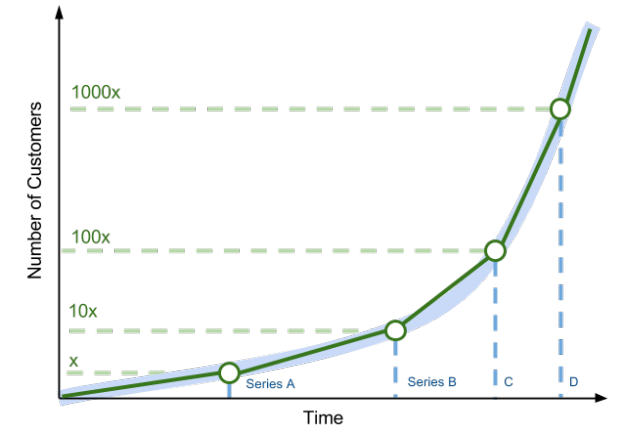As an engineer, one of the first things you are taught is how to break down a problem into smaller and more manageable problems. Want to build a bridge? First, you’ll need to design the supports and the connections with existing roads, then the external structure. Building a house? You start with the foundation, then the frame, then the plumbing.
Building a company is no different. Billion dollar companies are not built overnight, they are built through a progressive series of steps. If you attempted to envision a billion dollar company from day zero, you would be overwhelmed by the challenge.
Take the following example of a high growth company’s life cycle:
This is an intimidating chart. The number of customers grows slowly at first and then hits an inflection point where it begins to grow exponentially. How in the world do you design a company that can grow this way? How can you plan for that kind of growth?
The short answer is that you can’t. You can get lucky and have it just happen, but that is so unlikely that you would be better off playing the lottery.
What you can do, is break down the problem into manageable phases:
Here the growth path is broken into four stages: Series A, B, C and D. These might correspond to your funding rounds or they might just be milestones that you set for your company. At each stage, you have acquired 10 times the customers that you had at the previous stage. While these are still aggressive goals, they are goals that you can achieve.
The key lesson here is not that you should plan out the entire lifetime of your company on day one. The lesson is that, whatever stage you might be at now, your next goal should be 10 times the customers you have today. Setting such a goal will force you to take a hard look at your company and think about what will need to change to achieve that next level. When passing from one level the next, the following are typically true:
- You will need to start doing things you have not done before.
- You will need to stop doing some things that helped get you this far, as they will start to become liabilities.
- You will need to continue doing what makes your company unique, the core of your identity.
What those things are will depend on the business and the level you are at today, but asking the questions will help you position the company for success. Even if you fail to achieve 10 times customer growth, you will have positioned the company well for growth and increased the overall value of your company.
Why should you aspire to being a high growth company and plan this way? It is true that slow growth companies can be very successful and often feel much more comfortable. However, the vast majority of wealth created in entrepreneurship comes from the high growth stages of business. It is during that high growth stage that your capital efficiency will be at its highest and hence the value of your company appreciate the most for the shareholders. For publicly traded companies, this is why high growth companies command a premium on their share price.
So, even if you are just starting your company today, think about how you will reach the next level of growth. Before you know it, you might achieve that milestone and be thinking about how you can grow by another 10 times.
This article was originally published at Sean on Startups, a blog about starting and growing companies.






